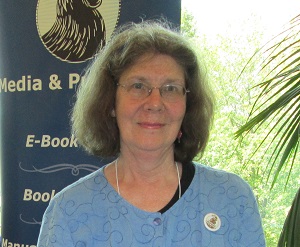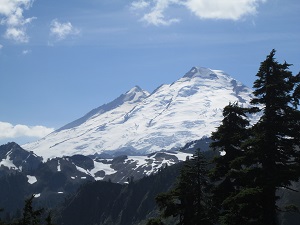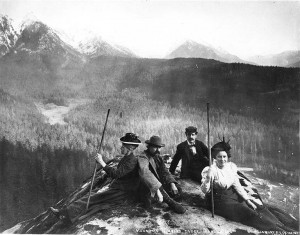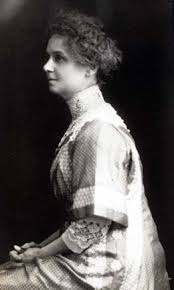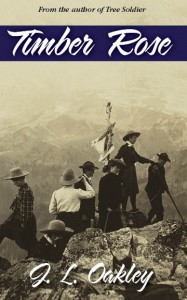Cozy mystery author Janet Oakley recounts the fascinating history of how Volcano House Hotel near Kīlauea Crater’s rim came to be.
~~~
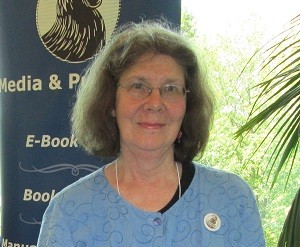 Relevant History welcomes back historical fiction author Janet Oakley, a history nerd and amateur gardener. Her fiction spans the mid-19th century to WW II with characters standing up for something in their own time and place. Her writing has been recognized with a 2013 Bellingham Mayor’s Arts Award, the Chanticleer Grand Prize for Tree Soldier, Goethe Grand Prize for The Jøssing Affair, 2018 Will Rogers Silver Medallion and 2018 WILLA Silver Awards for Mist-chi-mas: A Novel of Captivity. Timber Rose was a 2015 WILLA Award finalist. A UH Manoa grad, she has special memories of the 1877 Volcano House, often teaching there. To learn more about Janet and her books, visit her web site, and follow her on Facebook and Twitter.
Relevant History welcomes back historical fiction author Janet Oakley, a history nerd and amateur gardener. Her fiction spans the mid-19th century to WW II with characters standing up for something in their own time and place. Her writing has been recognized with a 2013 Bellingham Mayor’s Arts Award, the Chanticleer Grand Prize for Tree Soldier, Goethe Grand Prize for The Jøssing Affair, 2018 Will Rogers Silver Medallion and 2018 WILLA Silver Awards for Mist-chi-mas: A Novel of Captivity. Timber Rose was a 2015 WILLA Award finalist. A UH Manoa grad, she has special memories of the 1877 Volcano House, often teaching there. To learn more about Janet and her books, visit her web site, and follow her on Facebook and Twitter.
*****
The island of Oahu has Diamond Head. Maui has Haleakala. But neither of these compare to the Big Island of Hawai’i’s active volcano at Kīlauea. Sacred to the Hawaiian goddess, Pele, and the darling of volcanologists worldwide, Kīlauea captured the imaginations of Europeans from their very first visit in the late 1790s. Soon, travelers from all over the world began to show up to see its “lava lakes.”
Early tourists on Kīlauea Crater’s rim
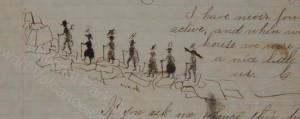 In 1823, Reverend William Ellis, an Englishman, made such a visit with American missionary, Asa Thurston. It was arduous journey of nearly twenty miles starting down by the ocean, crossing a lava desert and eventually arriving at the north end of Kilauea Crater. Ellis wrote, “We stopped and trembled.” He then went on to describe Kīlauea:
In 1823, Reverend William Ellis, an Englishman, made such a visit with American missionary, Asa Thurston. It was arduous journey of nearly twenty miles starting down by the ocean, crossing a lava desert and eventually arriving at the north end of Kilauea Crater. Ellis wrote, “We stopped and trembled.” He then went on to describe Kīlauea:
Immediately before us yawned an immense gulf, in the form of a crescent, about two miles in length, from north-east to south-west, nearly a mile in width, and apparently 800 feet deep. The bottom was covered with lava.
On the north rim of the crater, their Hawaiian guides set up a hut for the night made of “a few green branches of trees, some fern leaves and rushes…” This was most likely one of the first tourist lodgings for travelers.
The 1840s brought both sightseers and explorers to Kīlauea. Between December 1840 and January 1841, the US Exploring Expedition, led by Lt. Charles Wilkes, visited Kīlauea while doing a survey trip to the summit of Mauna Loa. With steady arrivals to the rim, a Hawaiian is said to have set up hut where he sold food to visitors. In 1846 Benjamin Pitman from Salem, Massachusetts, erected a one room grass shelter at the crater’s rim. For a dollar a day a visitor could sleep on a mat floor. He soon gave up the enterprise, but he left a name for the structure—Volcano House.
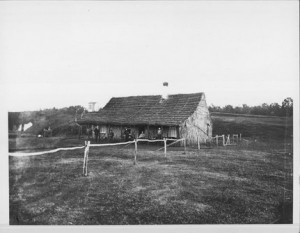 In 1866, George W.C. Jones of Keauhou, Hawaii, who had made his fortune in pulu (a popular soft fiber from the hapu’u fern and used for upholstery stuffing), went in partnership with Charles and Jules Richardson to build a more substantial wood structure. Overlooking Kilauea Crater, the building had a pili thatch roof with four bedrooms, parlor, and dining room inside. Mark Twain came for a visit in 1866 and wrote about Volcano House in Roughing It:
In 1866, George W.C. Jones of Keauhou, Hawaii, who had made his fortune in pulu (a popular soft fiber from the hapu’u fern and used for upholstery stuffing), went in partnership with Charles and Jules Richardson to build a more substantial wood structure. Overlooking Kilauea Crater, the building had a pili thatch roof with four bedrooms, parlor, and dining room inside. Mark Twain came for a visit in 1866 and wrote about Volcano House in Roughing It:
Neat, roomy, well-furnished and a well-kept hotel. The surprise of finding a good hotel at such an outlandish spot startled me, considerably more than the volcano did.
Six years later, another famous personage visited Volcano House. Englishwomen Isabella Bird was already well known as a travel writer and explorer when she arrived on the Big Island in 1872 to climb Mauna Loa. She later wrote of arriving at Volcano House in the dark:
Rarely was light more welcome than that which twinkled from under the verandah of the lonely crater house into the rainy night. The hospitable landlord of this unique dwelling lifted me from my horse, and carried me into a pleasant room thoroughly warmed by a large wood fire…
A new building, more visitors
By 1877, Volcano House was overflowing with visitors who came to watch Kīlauea’s live eruptions and lava lakes from the inn’s porch. It was time to build a larger, more comfortable Volcano House Hotel. The three partners hired architect Willian Lentz to accomplish this. Lentz’s design was the first Western-styled structure in Volcano. Doors, windows and building materials were brought from the coast of Keauhou on horseback and two-wheeled carts. The rafters, posts and studs for the hotel were hand hewn from native ‘ohi‘a and naio (false sandalwood) hardwood. This new inn boasted a central main room with fireplace, six guest rooms to the right of it, and a parlor and manager’s quarters to the left. Colonel John Henry and Emma Maby were hired to run it. A travel writer from San Francisco in 1880 glowed about the rooms and bed being “scrupulously clean…and the fare of excellent variety…”
In 1889, Robert Louis Stevenson visited the Big Island, but did not go up due to his health.
In 1893, Volcano House went under another remodel. A two-story addition of fourteen rooms was added onto the left end of the original structure, becoming the main part of the hotel. An observation tower and a larger dining hall were also added. The main room of the 1877 structure was now the “parlor.”
A new life and purpose
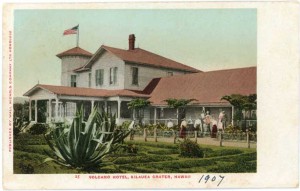 Over the decades, Volcano House changed owners several times. When the Inter-Island Steam Navigation Company took over in in 1921, a new two-story wing was built, bringing the number of rooms to 115. Sadly, the 1877 structure was sawn apart and moved to a new location away from the cliff. There it served as quarters for the hotel employees and sometimes furniture storage. In 1940, it briefly functioned as an interim lobby and bar when the 1921 Volcano House burned down. It began to fall into disrepair after today’s present hotel was built.
Over the decades, Volcano House changed owners several times. When the Inter-Island Steam Navigation Company took over in in 1921, a new two-story wing was built, bringing the number of rooms to 115. Sadly, the 1877 structure was sawn apart and moved to a new location away from the cliff. There it served as quarters for the hotel employees and sometimes furniture storage. In 1940, it briefly functioned as an interim lobby and bar when the 1921 Volcano House burned down. It began to fall into disrepair after today’s present hotel was built.
In 1971, nearly 100 years after it was constructed, a local photographer and architect student rented the deserted 1877 building for a wilderness photography class. The classes were so successful that the photographer approached the Park Superintendent with the idea of using the building on a permanent basis. Volcano residents interested in the arts joined in.
In 1974, permission was granted. Now listed on the National Register as Hawai’i’s oldest visitor accommodation, the 1877 Volcano House displays the works of three hundred Hawai’i artists and presents cultural programs as the Volcano Art Center. From a grass hut in the 1840s during the time of the Royal Hawaiian Kingdom through territory and statehood and its latest manifestation, Volcano House has always brought aloha to visitors coming to stand in awe of nature on the rim of the world’s most accessible volcano, Kīlauea.
*****
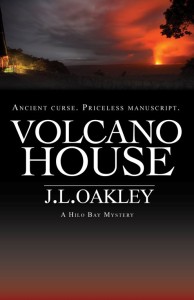 A big thanks to Janet Oakley! She’ll give away one ebook copy of her cozy mystery, Volcano House, to one person who contributes a comment on my blog this week. I’ll choose the winner from among those who comment by Friday at 6 p.m. ET. Delivery is available worldwide.
A big thanks to Janet Oakley! She’ll give away one ebook copy of her cozy mystery, Volcano House, to one person who contributes a comment on my blog this week. I’ll choose the winner from among those who comment by Friday at 6 p.m. ET. Delivery is available worldwide.
**********
Did you like what you read? Learn about downloads, discounts, and special offers from Relevant History authors and Suzanne Adair. Subscribe to Suzanne’s free newsletter.

